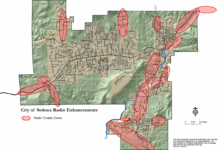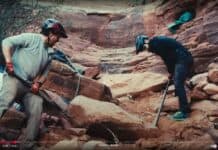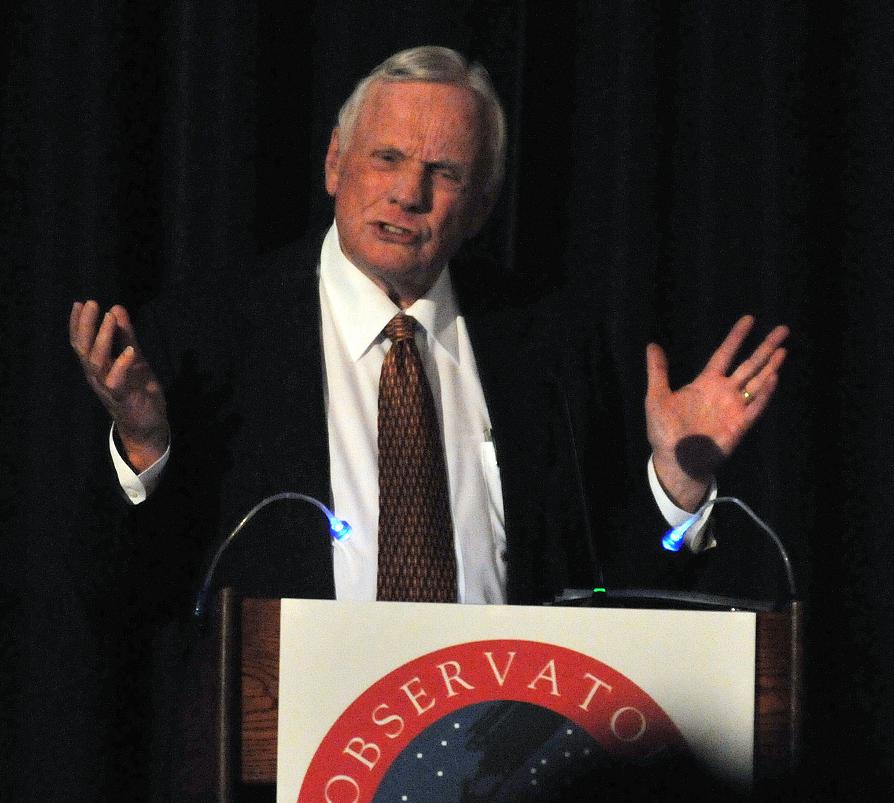Neil Armstrong walked on the moon for the first time Saturday, July 21, or at least that’s how it felt for the several hundred people who attended the former NASA astronaut’s speech in Flagstaff , 43 years and one day after Armstrong became the first human to set foot on the moon July 20, 1969.
The normally reclusive Armstrong, 81, came to Flagstaff for the unveiling of the first image officially recorded by the Discovery Channel Telescope, located near Happy Jack, east of Sedona.
Lowell Observatory Director Jeffrey Hall, Ph.D., unveiled the “first light” image. The DCT astronomers chose an image of Messier 109, a barred-arm galaxy roughly 83.5 million light years from Earth located in the constellation Ursa Major. Even though the official focus of the event was the DCT, the highlight of the evening was the man who first set foot on a celestial body millions of light years closer than M-109.
“Almost a half-century ago, some astronomers designed an experiment,” Armstrong said. “The idea was deceptively simple: Compute the distance between the Earth and the Moon based on the time it would take for a beam of light to travel up to a mirror located on the surface of the Moon and to reflect it back to Earth.”
“I wasn’t one of the scientists on this project — I was sort of a technician. My job in the experiment was to install the mirror,” Armstrong said.
“After a three-and-a-half day trip to the site I set about the job of unloading the mirror,” he said. There were actually 100 mirrors, all about the size of “half of an orange,” he said.
“From the Sea of Tranquility, the Earth hung above me 23 degrees west of the zenith, a turquoise pendant against a black velvet sky,” Armstrong said.
The astronomical peculiarity of the moon being in tidal lock — the same side always faces the Earth — permitted the Lunar Laser Ranging Experiment to be successful, Armstrong said. The laser beam would yield an accuracy of the distance between 11 and 17 inches.
“It may not be obvious why anyone would want to measure the distance to the Sea of Tranquility within 11 inches, but we had to have some way of confirming our mileage for our expense account,” Armstrong said.
For the laser at the Lick Observatory on Mount Hamilton near San Jose, Calif., to hit the lunar mirrors was the equivalent of shooting a dime with a rifle from about two miles away, Armstrong said. The astronomers began shooting lasers as soon as Armstrong was finished, but they didn’t receive a signal back. They started adjusting their calculations and discovered the observatory had been using the wrong latitude and longitude since it was built in 1888.
“So the first result from a set of mirrors on the moon was finding the true position of Mount Hamilton on Earth,” Armstrong said.
Experiments with the mirrors have since determined the moon is moving away from Earth at 3.8 centimeters a year, and oscillations in the measurements suggest the moon has a liquid core. The mirrors were also used to prove the equivalence principle of general relativity but called into question the ability for general relativity to adequately explain the Earth-moon-sun gravitational system.
“For an experiment that had little practical value in the eyes of many, that’s a decent result,” Armstrong said. “The mirrors are expected to be busy for many years to come, which gives me enormous satisfaction as a technician on the project.”
The DCT, however, will not focus on the moon or pinpointing locations on the Earth, Armstrong said, but instead gaze into the far reaches of the cosmos to study the life cycles of stars.
The sun around which we orbit is a middle-aged star, Armstrong said. It will eventually swell into a red giant and swallow the Earth and the inner planets, but long before that the Earth’s rotation will slow, and it will tidally lock to the sun, searing one face while freezing the other.
“Everyone will be moving toward the edges. Never will the phrase ‘location, location, location,’ be more persuasive,” Armstrong said.
This end is not imminent though, he said.
“A million generations will not bring it virtually closer. But we can conjure a hundred reasons to require an earlier migration from Earth,” Armstrong said: Population growth, a change in our atmosphere, radiation and other threats which could result in our extinction as a species — nuclear holocaust, epidemic disease, a collision with a comet or asteroid.
“The home of the human species is not inherently restricted to Earth alone. The universe around us is our challenge and our destiny,” Armstrong said. Humanity will leave Earth and settle on other natural planets or man-made habitats.
“We can’t help but wonder what sorts of astronomical discoveries and consequent societal developments the Discovery Channel Telescope might engender,” Armstrong said.
Computer advancement alone has progressed by leaps and bounds. Apollo 11’s 70-pound computer had 30,000 KB of memory and 2,000 KB of RAM, Armstrong said — in total about 15 seconds of a modern MP3 song.
Armstrong then demonstrated another advancement in technology, revealing a 2012 video created by an amateur astronomer who took images from Lunar Reconnaissance Orbiter, launched in 2009, GoogleMoon and NASA file photos, to painstakingly recreate the last 20 minutes of Apollo 11’s descent.
Using a split screen of the last four minutes and audio from the 1969 mission, Armstrong brought the audience along for a virtual landing, occasionally pausing to explain various alarms in the Eagle module and his decision to take off autopilot and land the craft manually to avoid boulders. The landing delay had reduced the available fuel to lift-off and threatened the mission’s success. With less than 20 seconds of fuel left, the lander appeared to touch the surface.
The already silent room collectively held its breath until Armstrong’s famous words, “The Eagle has landed,” brought the room to thunderous applause.
Armstrong saved his last words for the young people who will benefit from the DCT’s discoveries another 43 years in the future.
“No doubt, you’ll see new mysteries that it has revealed for future astronomers, astrophysicists and cosmologists to solve,” Armstrong said. “So to all of you who played a part in making the DCT a reality, congratulations and thanks. And thanks to everyone here for being a part in this civilization.”
Neil Armstrong Narrating his Apollo 11 Moon Landing
Neil Armstrong narrates a Google Moon video synchronized with original footage, taken from the lunar module Eagle, during his landing 20 July 1969. Video produced by GoneToPlaid, using Google Moon and on-board Data Acquisition Camera footage. This video is the world premiere at CPA 125th anniversary event, at which Neil was guest speaker, on August 24, 2011 in Sydney, Australia.
Armstrong provided a similar narration at the event in Flagstaff on Saturday, July 21, 2012.



















